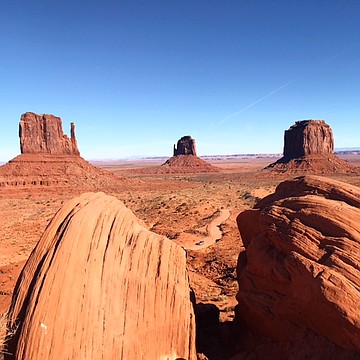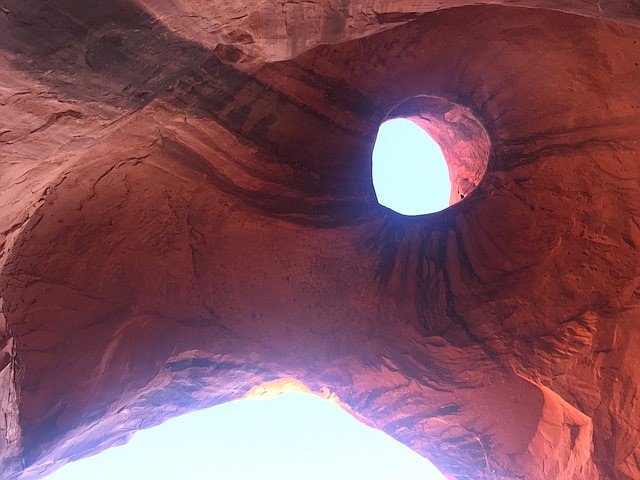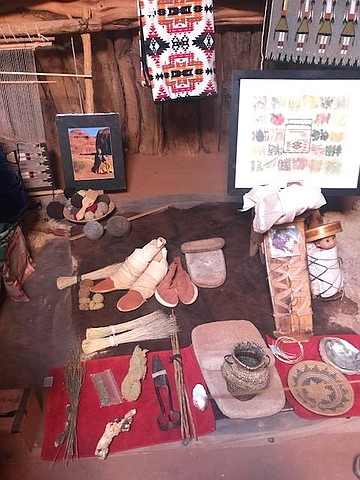 Facebook
Facebook
 X
X
 Instagram
Instagram
 TikTok
TikTok
 Youtube
Youtube

“Be still and the earth will speak to you." ~ Navajo saying
Monument Valley. Just the name conjures up images of the majestic, iconic buttes and classic western landscape so often seen in movies and magazines.
When John Wayne saw MV for the first time he mused, “So this is where God put the West.” John Ford loved filming here and called it “the most complete, beautiful, and peaceful place on earth.” A visit to Monument Valley, however, can offer up more than beautiful, evocative scenery.

The MV Navajo Tribal Park covers 91,000 acres. Upon entering MV, you can drive the rough 18-mile dirt road encircling the majestic buttes on your own (4WD is preferable, but not required). Exploring on your own, however, restricts what you are able to see.
To leave the loop road, you must have a Navajo guide. I recommend you do this. There are sights off the road that took my breath away! More importantly, if you go with a Navajo guide, you are afforded a glimpse into a native culture that has existed for thousands of years. Through this perspective-altering lens, Monument Valley is transformed into something more profound: a sacred spot that can provide a transcendent cultural experience.
The history of Monument Valley is woven into 20th century American popular culture. When people around the world think about the American West, they think about Monument Valley. Some of the vistas in MV inevitably look eerily familiar to movie fans who have never been near the area. Classic westerns have been filmed there since the days of Wayne and Ford. Stagecoach and The Searchers are just two of the classics these icons of the American Western teamed up on here.
Today, directors still opt to film in Monument Valley. Easy Rider, National Lampoon’s Vacation, The Lone Ranger, and Mission Impossible are just a few of the films in the past half century that have included scenes filmed here. To be able to film in MV, producers and directors must first obtain permission from the Navajo tribe, for Monument Valley is not a national park, but part of the Navajo Nation. They own the rights to the area and often okay these projects as the film industry, along with tourism, has helped provide much needed financial support to the Navajo.
Novelist Zane Grey helped draw the public’s (and Hollywood’s) attention to the area in the 1920s with his descriptive novels mixing the mythos of the frontier with lyrical, enchanting descriptions of the landscape. In one of his books he describes a flash of lightning “revealing a vast valley, a strange world of colossal shafts and buttes of rock, magnificently sculptured, standing isolated and aloof, dark, weird, lonely.” Such portraits enhanced the area's mystique.
The land shifted between Anglo and Native American control for decades until white people lost faith in its mining potential and gave up control to the Navajo. Harry Goulding, however, did not abandon the area. After years bartering with the Navajo, he established Goulding’s Trading Post in the 1920s — and it’s still a fixture today. After the Depression, Harry made his way to Hollywood to gauge interest in his beloved MV. He showed some photos of the landscape to the location manager for Stagecoach, who had previously derided Goulding for “wasting my time.” The rest is history. Years later, John Wayne proclaimed to Goulding, “Harry, you and I owe these monuments a lot.”
The View Hotel, built by the Navajo in 2008, is the last stop before entering the MV Tribal Park. The Navajo made sure that every room in the hotel offered a spectacular lookout over the buttes. Even if you don’t stay here, it’s a worthwhile stop to catch your first breathtaking glimpse of the iconic buttes, some as high as skyscrapers. This is where I met my Navajo guide.
I chose Navajo Spirit Tours after reading several glowing reviews. They offer several tours including the Sunrise, Full Day, and the one I chose, the Sunset tour. If you want to explore the canyons, buttes and mesas beyond the standard allowed area, take one of these tours. The Navajo guides have intimate knowledge of the cultural and geological features of the valley as well as fascinating cultural insights.
As we began our ride down the 18-mile rough and bumpy dirt road that traverses the valley, I held tightly onto my smartphone. The Navajo have resisted paving the road for fear of the hordes of visitors that they believe would inevitably follow. We rumbled for a few moments down the rough road before pausing for a photo opportunity at the Mittens, the most famous buttes in MV. These are the ones often seen in photos and postcards. You can hike around the Mittens, but you’ll need to obtain a permit to do so.
We then paused at John Ford’s Point, which offers a panoramic view that makes you understand how Ford fell in love with the place. You can take photos and selfies to your heart’s content. Don’t forget to pick up some fry bread at the refreshment stand on the point. This was my first time trying it and it reminded me just a bit of beignets from New Orleans, famously served at Café du Monde.
Next up was a visit to a female hogan, a traditional Navajo residential structure. The nine posts of the hogan symbolize nine months of pregnancy. We entered the cozy living quarters festooned with cultural items, many with a symbolic significance. The guide explained the importance of each and its connection with the Navajo culture.

We next arrived at a huge natural arch called Big Hogan. Our guide asked us to lie on our backs and look up. Almost mystically, an outline of an eagle’s head appeared, quite a fitting image as eagles were considered by the Navajo to be spiritual messengers. Another rock presented an image that appeared to be the head of a Mohawk. Under the enchanting natural acoustics of the arch, our guide sang some Navajo songs and played others on his flute. After the performance, he spoke of the efforts being made to document the Navajo oral tradition for future generations.
At each stop our guide had an interesting anecdote, piece of history, or story to tell us. Most of these stories had been passed down through the generations. Some were stories of Navajo legend and mythology. Others were interpretations of the petroglyph drawings that are scattered throughout Monument Valley, many left by the Anasazi dating back thousands of years. He also taught us some Navajo sayings such as tse bii ndzisgaii, which means “clearing among the rocks.”

The tourism industry is extremely important to the Navajo, providing a significant percentage of their employment. Even so, only about half of Navajo are employed. Despite the money they’ve brought in through movie rights and tourism, many Navajo struggle economically. Only 34% of the people have water and electricity. About 10% of Navajo have bachelor’s degrees. More young Navajo are leaving Navajo Nation for Phoenix, L.A. and Albuquerque. This migration, sometimes called the Navajo brain drive, is looked upon with some sadness by the older generation who view the Navajo as traditionally tied with their land and family. Yet some of the younger generation Navajo return after their higher education to make a difference in the community, such as the Ph.D. who returned to help clean up uranium contamination. The importance of family ties and cultural ceremonies, underscored by frequent large clan gatherings, remain strong. Certain practices such as arranged marriages were developed out of economic necessity and intended to sustain the tribe. Most younger generation Navajo prefer to marry independently. The Navajo call themselves the Diné (the People) and there is in fact a Diné newspaper, The Navajo Times.
While I generally prefer to head out on my own to explore such areas of great natural beauty, in my opinion it’s worth it to take a tour if you can swing the extra bucks. It left me energized, inspired to learn more about Navajo culture, and gratified to help support the Navajo while being offered some insight amidst the magnificent scenery of Monument Valley.


“Be still and the earth will speak to you." ~ Navajo saying
Monument Valley. Just the name conjures up images of the majestic, iconic buttes and classic western landscape so often seen in movies and magazines.
When John Wayne saw MV for the first time he mused, “So this is where God put the West.” John Ford loved filming here and called it “the most complete, beautiful, and peaceful place on earth.” A visit to Monument Valley, however, can offer up more than beautiful, evocative scenery.

The MV Navajo Tribal Park covers 91,000 acres. Upon entering MV, you can drive the rough 18-mile dirt road encircling the majestic buttes on your own (4WD is preferable, but not required). Exploring on your own, however, restricts what you are able to see.
To leave the loop road, you must have a Navajo guide. I recommend you do this. There are sights off the road that took my breath away! More importantly, if you go with a Navajo guide, you are afforded a glimpse into a native culture that has existed for thousands of years. Through this perspective-altering lens, Monument Valley is transformed into something more profound: a sacred spot that can provide a transcendent cultural experience.
The history of Monument Valley is woven into 20th century American popular culture. When people around the world think about the American West, they think about Monument Valley. Some of the vistas in MV inevitably look eerily familiar to movie fans who have never been near the area. Classic westerns have been filmed there since the days of Wayne and Ford. Stagecoach and The Searchers are just two of the classics these icons of the American Western teamed up on here.
Today, directors still opt to film in Monument Valley. Easy Rider, National Lampoon’s Vacation, The Lone Ranger, and Mission Impossible are just a few of the films in the past half century that have included scenes filmed here. To be able to film in MV, producers and directors must first obtain permission from the Navajo tribe, for Monument Valley is not a national park, but part of the Navajo Nation. They own the rights to the area and often okay these projects as the film industry, along with tourism, has helped provide much needed financial support to the Navajo.
Novelist Zane Grey helped draw the public’s (and Hollywood’s) attention to the area in the 1920s with his descriptive novels mixing the mythos of the frontier with lyrical, enchanting descriptions of the landscape. In one of his books he describes a flash of lightning “revealing a vast valley, a strange world of colossal shafts and buttes of rock, magnificently sculptured, standing isolated and aloof, dark, weird, lonely.” Such portraits enhanced the area's mystique.
The land shifted between Anglo and Native American control for decades until white people lost faith in its mining potential and gave up control to the Navajo. Harry Goulding, however, did not abandon the area. After years bartering with the Navajo, he established Goulding’s Trading Post in the 1920s — and it’s still a fixture today. After the Depression, Harry made his way to Hollywood to gauge interest in his beloved MV. He showed some photos of the landscape to the location manager for Stagecoach, who had previously derided Goulding for “wasting my time.” The rest is history. Years later, John Wayne proclaimed to Goulding, “Harry, you and I owe these monuments a lot.”
The View Hotel, built by the Navajo in 2008, is the last stop before entering the MV Tribal Park. The Navajo made sure that every room in the hotel offered a spectacular lookout over the buttes. Even if you don’t stay here, it’s a worthwhile stop to catch your first breathtaking glimpse of the iconic buttes, some as high as skyscrapers. This is where I met my Navajo guide.
I chose Navajo Spirit Tours after reading several glowing reviews. They offer several tours including the Sunrise, Full Day, and the one I chose, the Sunset tour. If you want to explore the canyons, buttes and mesas beyond the standard allowed area, take one of these tours. The Navajo guides have intimate knowledge of the cultural and geological features of the valley as well as fascinating cultural insights.
As we began our ride down the 18-mile rough and bumpy dirt road that traverses the valley, I held tightly onto my smartphone. The Navajo have resisted paving the road for fear of the hordes of visitors that they believe would inevitably follow. We rumbled for a few moments down the rough road before pausing for a photo opportunity at the Mittens, the most famous buttes in MV. These are the ones often seen in photos and postcards. You can hike around the Mittens, but you’ll need to obtain a permit to do so.
We then paused at John Ford’s Point, which offers a panoramic view that makes you understand how Ford fell in love with the place. You can take photos and selfies to your heart’s content. Don’t forget to pick up some fry bread at the refreshment stand on the point. This was my first time trying it and it reminded me just a bit of beignets from New Orleans, famously served at Café du Monde.
Next up was a visit to a female hogan, a traditional Navajo residential structure. The nine posts of the hogan symbolize nine months of pregnancy. We entered the cozy living quarters festooned with cultural items, many with a symbolic significance. The guide explained the importance of each and its connection with the Navajo culture.

We next arrived at a huge natural arch called Big Hogan. Our guide asked us to lie on our backs and look up. Almost mystically, an outline of an eagle’s head appeared, quite a fitting image as eagles were considered by the Navajo to be spiritual messengers. Another rock presented an image that appeared to be the head of a Mohawk. Under the enchanting natural acoustics of the arch, our guide sang some Navajo songs and played others on his flute. After the performance, he spoke of the efforts being made to document the Navajo oral tradition for future generations.
At each stop our guide had an interesting anecdote, piece of history, or story to tell us. Most of these stories had been passed down through the generations. Some were stories of Navajo legend and mythology. Others were interpretations of the petroglyph drawings that are scattered throughout Monument Valley, many left by the Anasazi dating back thousands of years. He also taught us some Navajo sayings such as tse bii ndzisgaii, which means “clearing among the rocks.”

The tourism industry is extremely important to the Navajo, providing a significant percentage of their employment. Even so, only about half of Navajo are employed. Despite the money they’ve brought in through movie rights and tourism, many Navajo struggle economically. Only 34% of the people have water and electricity. About 10% of Navajo have bachelor’s degrees. More young Navajo are leaving Navajo Nation for Phoenix, L.A. and Albuquerque. This migration, sometimes called the Navajo brain drive, is looked upon with some sadness by the older generation who view the Navajo as traditionally tied with their land and family. Yet some of the younger generation Navajo return after their higher education to make a difference in the community, such as the Ph.D. who returned to help clean up uranium contamination. The importance of family ties and cultural ceremonies, underscored by frequent large clan gatherings, remain strong. Certain practices such as arranged marriages were developed out of economic necessity and intended to sustain the tribe. Most younger generation Navajo prefer to marry independently. The Navajo call themselves the Diné (the People) and there is in fact a Diné newspaper, The Navajo Times.
While I generally prefer to head out on my own to explore such areas of great natural beauty, in my opinion it’s worth it to take a tour if you can swing the extra bucks. It left me energized, inspired to learn more about Navajo culture, and gratified to help support the Navajo while being offered some insight amidst the magnificent scenery of Monument Valley.
Comments